Delos is a small strip of land near Mykonos, but don’t let its small size fool you since this island is one of Greece’s most important archaeological, historical, and mythological sites. The entire island is an excavation site, one of the largest ones in the Mediterranean, and it’s a fantastic experience to walk among the ruins and see how the ancient Greeks used to live.
Delos gets even more attractive in a mythological sense since the island is the birthplace of the twin gods Artemis and Apollo. Due to that, many considered Delos a holy sanctuary island. Because of this glorious past and everything that comes with it, UNESCO declared Delos a part of the World Heritage List back in 1990.
We visited the island on a sunny day in the summer of 2021 while onboard Running on Waves. While we researched the islands and places we would visit during our cruise, we learned about Delos and were genuinely excited to see it.
But before we show you some of the pictures we took there, let us explain a bit about the island’s history and what happened there.

A brief lesson on the mythology of Delos
Before going into history, we must say that Delos’s geographical location was critical to island development. Since it’s located roughly at the center of the Cyclades and almost in the middle of the route between the eastern Greek islands and the mainland, it was only natural that Delos became a harbor.
Later, it developed into one of the most important ports in the eastern part of the Mediterranean.
By the time Homer had written the Odyssey, Delos was already a famous place because it was called the birthplace of the twin gods. This was a significant factor in the island’s success, and the legend connected to the birth of Apollo and Artemis is well known.
If you are looking for a yacht-style experience in a small ship with excellent food and service, we think we have the thing for you. Go check our article about the Aegean Cruise on Running on Waves.
When you book your cruise, use the code fotostrassecruiseonwaves for a 5% discount on top of their regular advanced booking discount.
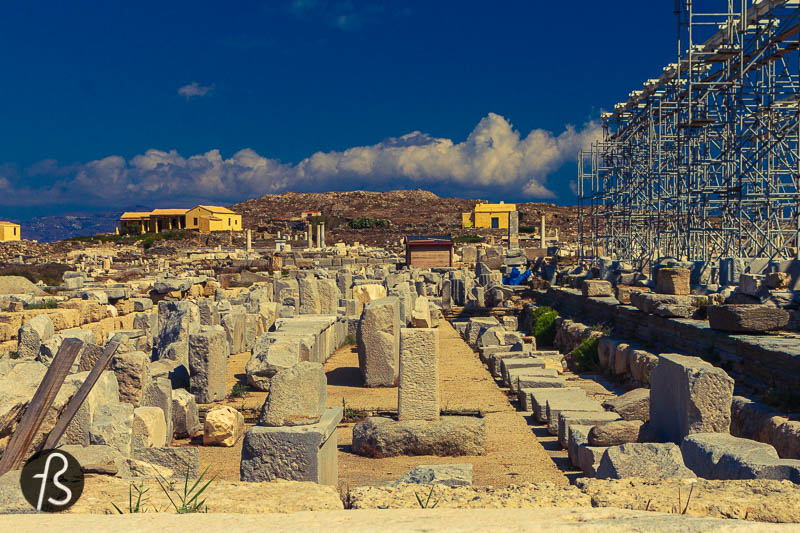
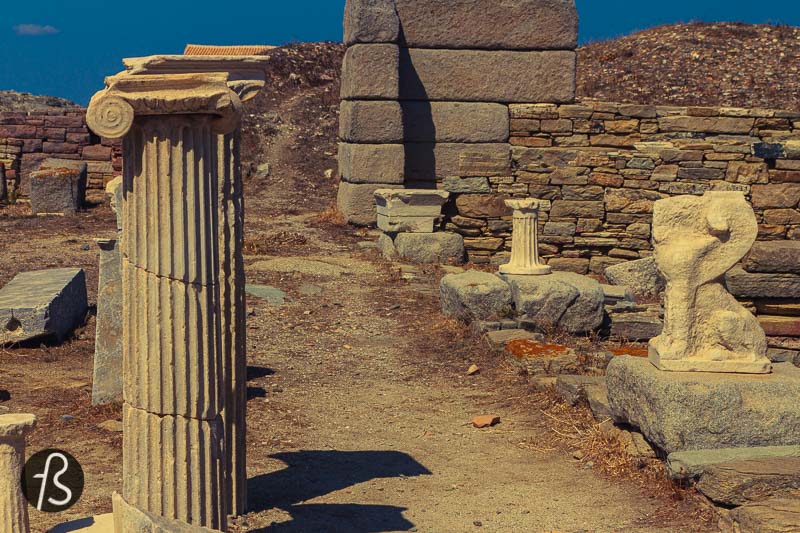
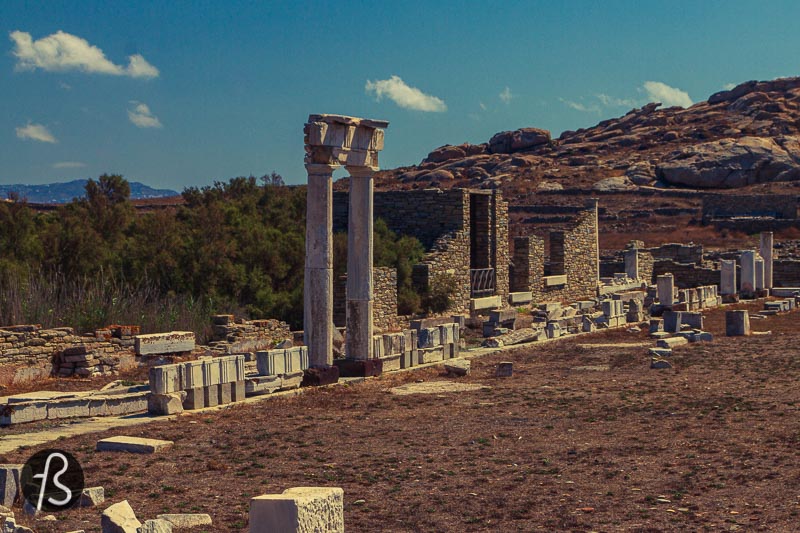
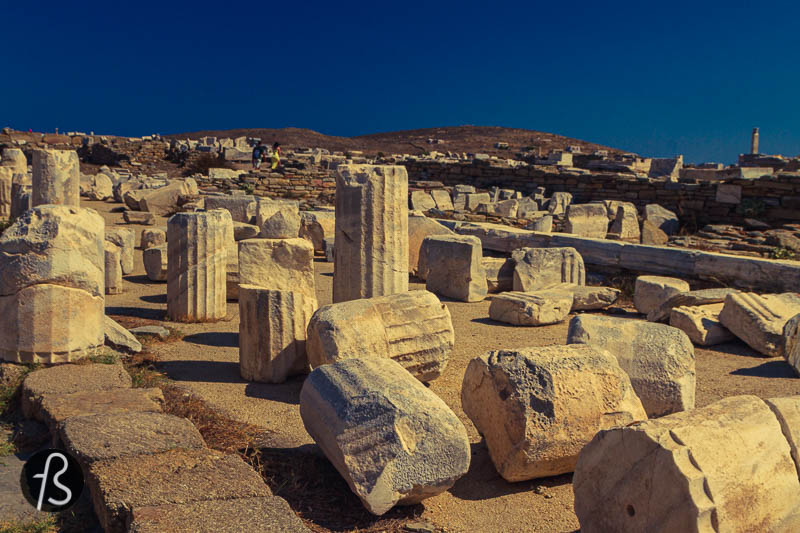

Zeus had an affair with the Titan Leto and left her pregnant, and when Hera learned about this, her jealousy became something else, and she started pursuing her rival. All of this left Leto without a safe place to give birth until she managed to find a piece of floating rock at sea. This is where she decided to stop and, despite her fears, she remained there after promising that the island would stop moving and stay in one place. Also, the child born there would never abandon its birthplace and bring glories, wealth, and riches.
After nine days of painful labour, Hera stopped the goddess of childbirth, Eileithyia, to help Leto. It was only later, after other goddesses who were friends with Leto sent Iris, the messenger of the gods, to fetch Eileithya, that everything went smoothly.
So, Leto gave birth to Apollo and Artemis while she looked at Mount Cynthus, a peak of pure granite that dominates the surroundings named after Zeus. Because of this, the island changed its name from A-Delos, the invisible island due to its constant movement, to Delos, which means clearly seen. The legend says that Delos is held in place by adamantine chains.
Apollo was a god with a split personality. He was worshipped in two different places, and he showed his different sides. In Delphi, a remote and mountainous site, he was a vengeful god who decided the fate of mortals. In Delos, Apollo was the god of light, music and joy of life. He was against anything that might pollute the purity and cleanliness of the island. And that included deaths and births; people had to die and give births elsewhere.
Apollo was the dominant god in Delos, and he was worshipped until later years as part of the Apollonian Trinity, with his sister Artemis and his mother, Leto. And you can see this in many artefacts that survived to tell the story of the island.
This is how Delos became one of the most important and sacred places in ancient Greece.
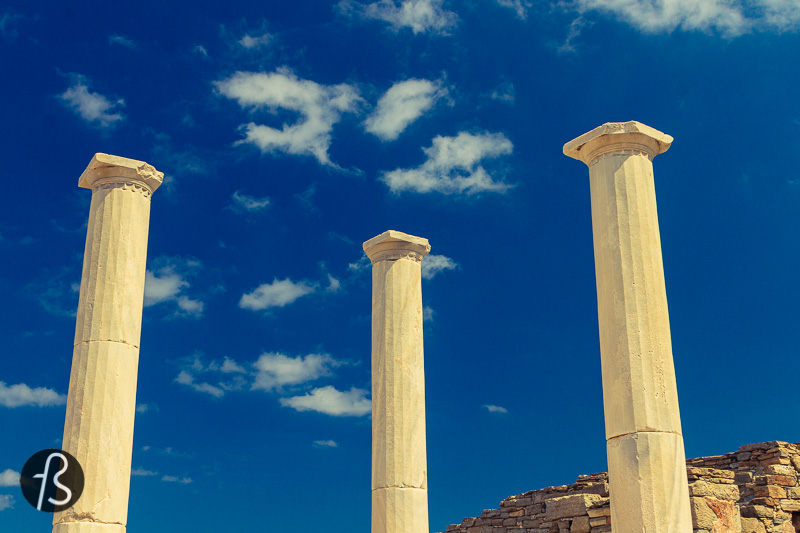


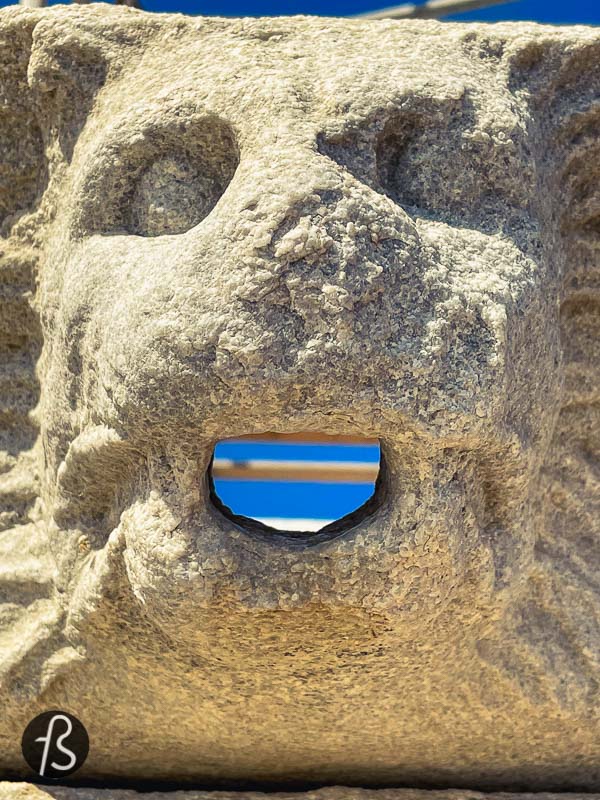

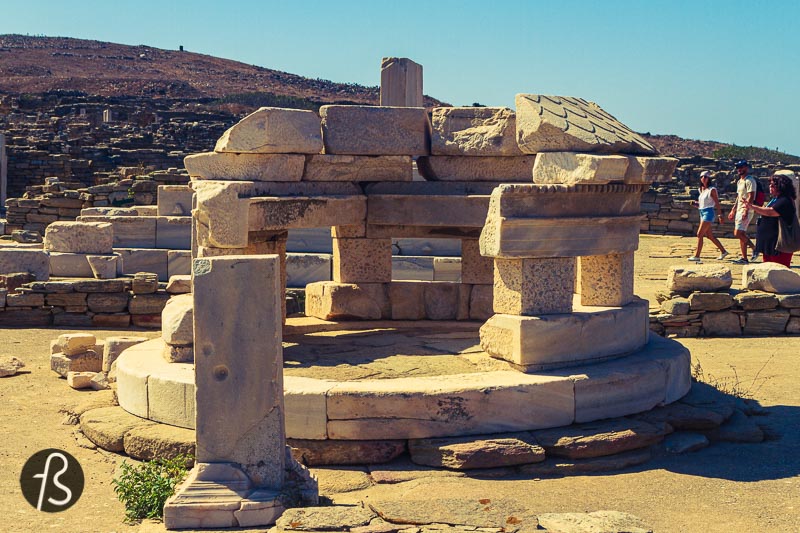
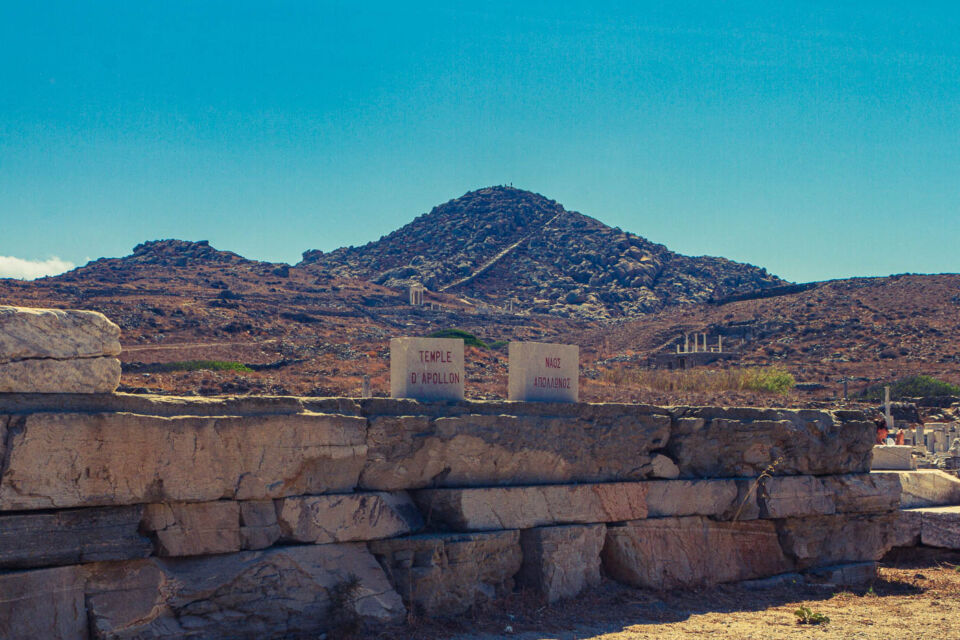
Now, a moment to talk about the history of Delos
There are traces of habitation on Delos from the 3rd millennium BC. These first settlers could have been one of the prehistoric people that lived in the Aegean sea. Maybe, they could be those who Thucydides, an Athenian historian and general from 400 BC, called Carians. Their remains were found high on Mount Cynthus. There were no traces of human presence during the next millennium as it happened in other Cycladic islands.
Delos first flourished during the Mycenaean period, from 1580 to 1200 BC. The main town spread into the fertile valley, and important buildings were developed around the harbour. Around 1100 BC, the Mycenaean period was over, and the Ionians left mainland Greece to settle on the island and the eastern part of the Mediterranean sea. This is the time when the Odyssey was written and where Delos appears as an Ionian holy place. A sacred island where boats of pilgrims would come, bringing goods and developing commerce in the town.
But when a place like Delos starts to acquire a reputation as an important religious place, other cities start thinking about using it for their own goals. This happened because a place of religious importance can have significant political influence as well.
The first people to try this was the Athenians, who erected a temple to Apollo and ordered the first purification of Delos during the reign of Pisistratus. This purification called for all graves that could be seen from the Apollo temple to be removed and placed on the nearby island of Rheneia, and there is a massive necropolis there until today.
During the Persian Wars, the influence of Athens ceased, and the Persian invaders respected the island holiness. But the main religious festival lost its importance since the islands around were also under Persian control. After the Persian wars were over, the Athenians took over the leadership of the Greek city-states and the Athenian League was settled in Delos. This also included their treasury which only moved back to Athens in 454 BC.
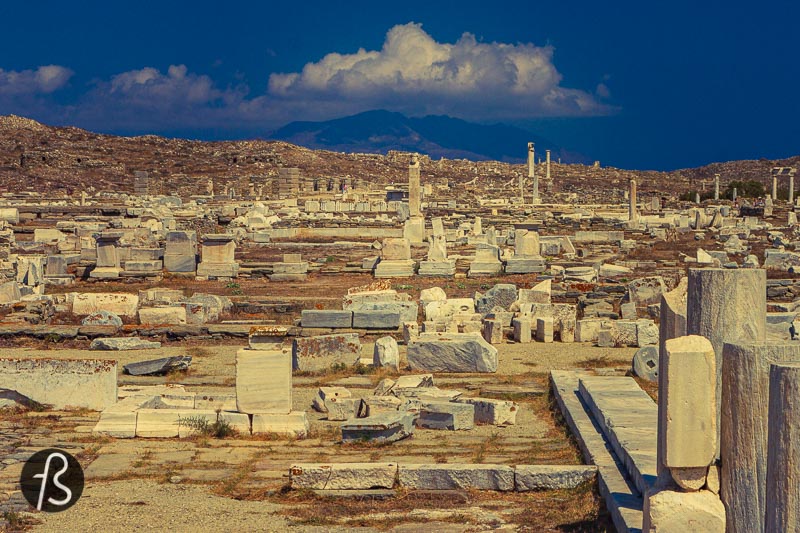
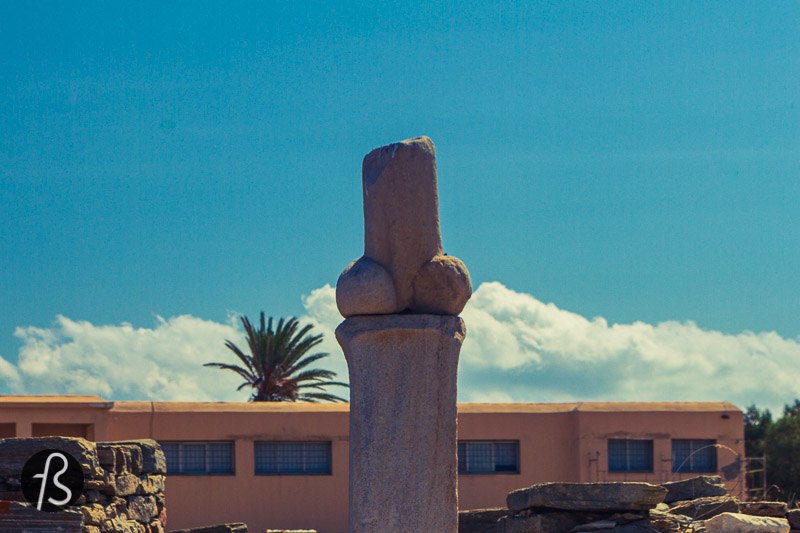
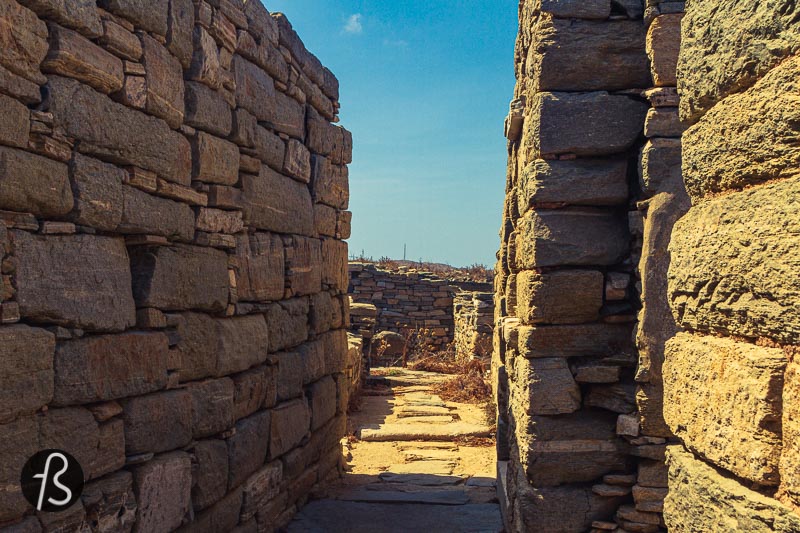
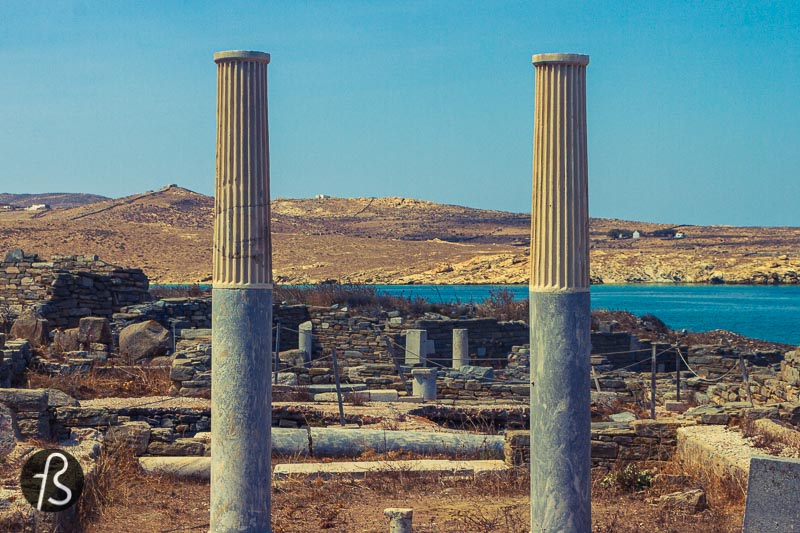

A second purification was held during the Athenian control over Delos, and the entire island was purged of dead bodies. A law forbidding anyone to die on the island was ordered as well, and nobody could be born in Delos as a way to preserve the island neutrality since no one could claim through inheritance. This second purification was followed by a new period of prosperity. The old festivals changed, a new, more significant temple was erected, and another celebration came to be held every five years.
The influence of Athens in Delos lasted throughout the 4th century BC. Only when the Macedonians took over the leadership of the Greek city-states Delos was proclaimed an independent and free city. This lasted from 314 BC until 166 BC, and it was marked by a period of prosperity. Due to his holiness, every leader competed to offer the greatest gifts to Apollo, and Delos changed to even greater importance. Both as a sacred place and as a commercial centre.
This was marked by large scale trade. Since its geographical position placed it in the centre of the Mediterranean trade routes, Delos became one of the main hubs for grain trade and slaves. Commercial goods from North Africa, Crimea, Syria, Egypt and West Asia were all traded there.
With all this cosmopolitan side to Delos, its sacred character dissipated a little. New gods, new religions appeared on the island. New houses were built, and more foreigners came to the island with the local Apollo sanctuary keeping good relations with all people. It all changed again when the last Macedonian King was defeated by the Romans.
Without the protection of the Macedonians, Delos was, once again, under the rule of the Athenians who were gifted the island by the Romans. Once the Athenians took over Delos, they expelled most of its inhabitants. They brought poor Athenians who were given plots of land but, through time, the island population changed again, and economic growth meant more people wanted to move there. At the beginning of the first century BC, Delos population may have been 25 thousand people. Many Athenians and Greeks from other city-states, Italians, Syrians, Egyptians, Palestinians, and Jews.
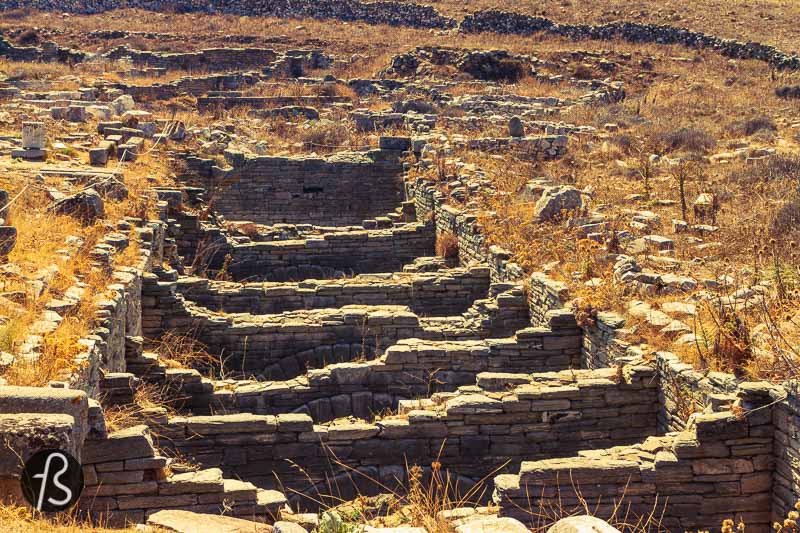
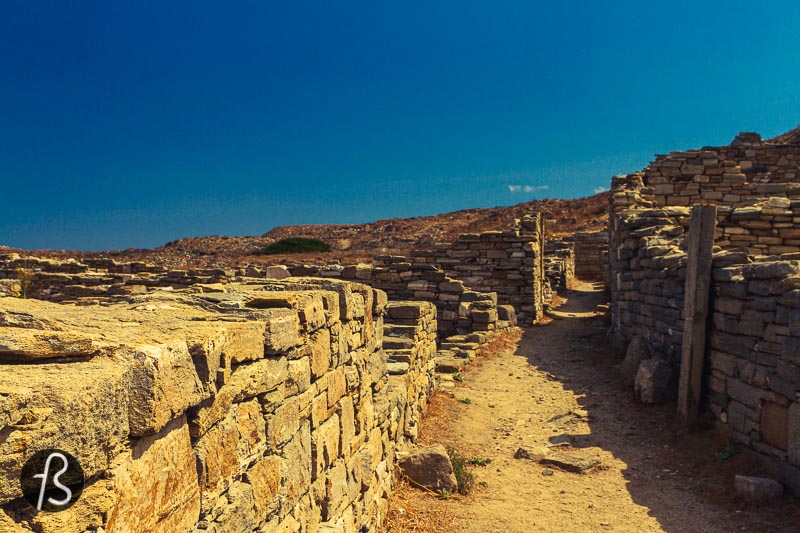
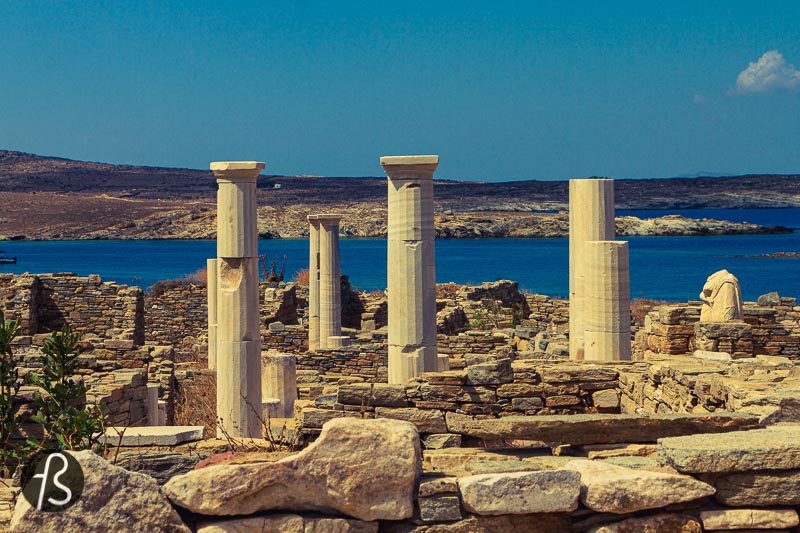
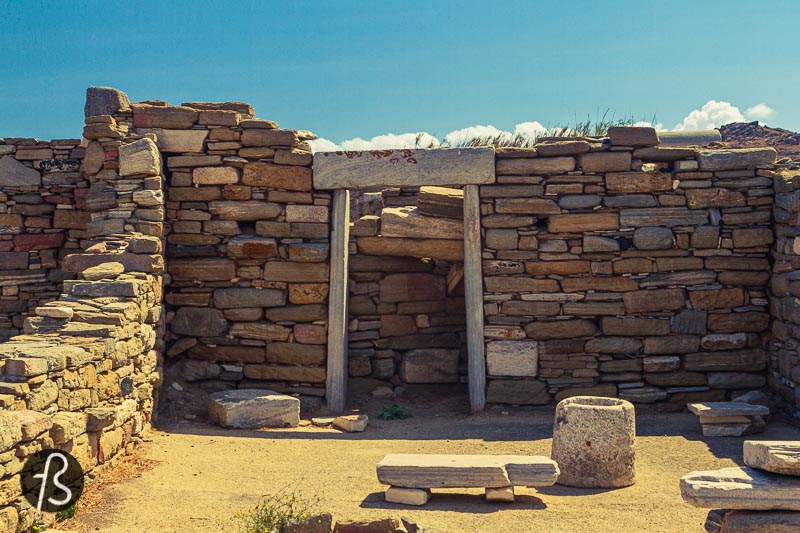
Even though Athenians had influence over the island, its true masters were the Romans. This closeness with Rome brought destruction to the island when it was attacked by the forces of Mithridates VI of Pontus in 88 BC. According to historical evidence, the destruction was almost complete, with a suggested death toll of nearly 20 thousand people.
During the Mithridatic Wars with Rome, Delos was attacked by pirates who were allies of Mithridates VI. This last raid in Delos destroyed everything remaining, and the island lost its sacred status and commercial importance.
Despite its decline after all this destruction, Delos continued to have some population during the early imperial Roman years. But houses were abandoned; some became workshops according to excavations, and others were just left empty. With all of this happening, Athenians and Romans lost interest in Delos, and the religious and sacred were not as they used to be.
The massive settlement in Delos changed size and was reduced to only a tiny part of what it used to be by the early Christians. By the end of the third century AD, there was a small Christian settlement on the island, and it seems like a few other churches were built on the island due to its abundance of materials from the ancient ruins. But this wasn’t enough to restore the status that Delos once held, and by the sixth century AD, no signs of life were noted on the island. A century later, it wasn’t even mentioned anymore in any of the Episcopal lists of churches.
But the history of Delos doesn’t stop here. In 727, it was pillaged by Byzantine troops. Slavs sacked the island in 763, and Cretans did the same in 821. Delos was left in ruins and destroyed. It passed from one governor to another, from the Venetians that took control over the island in medieval times to the Knights of St. John of Malta that was there for a short time. The Turks took over in 1566, and pirates were there during the Ottoman occupation. And through time, Delos and its neighbour island of Rheneia were almost forgotten.
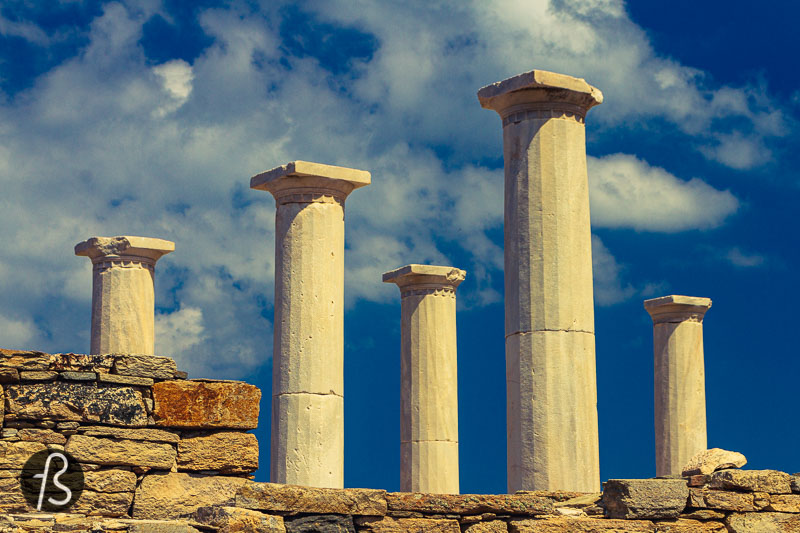
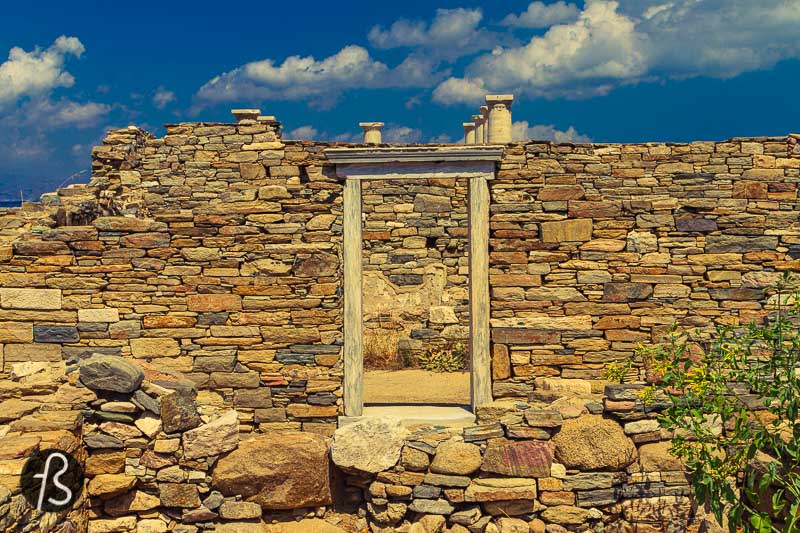
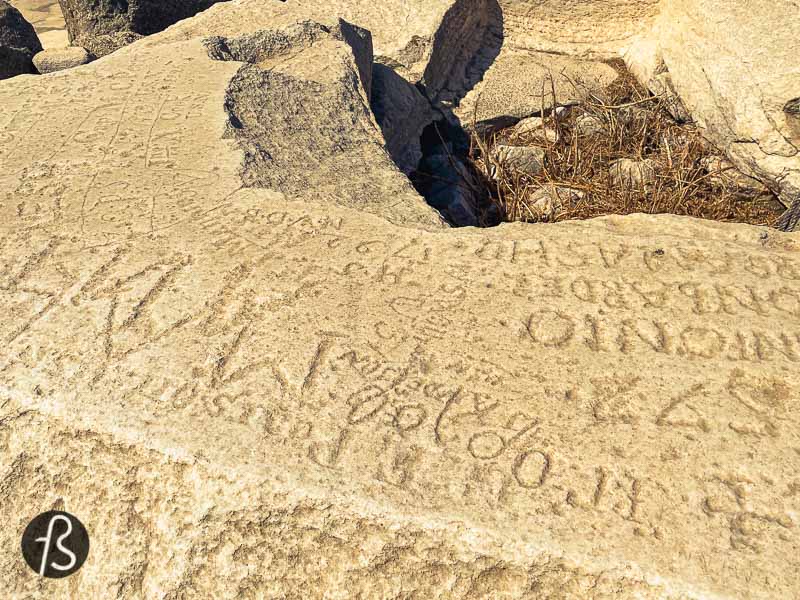
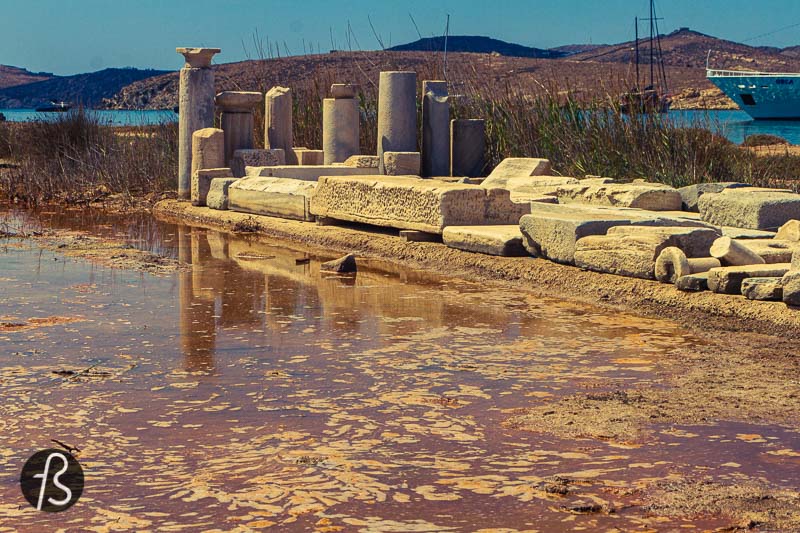
Delos remained unknown to Western Europe until the Renaissance. Archaeological interest in the island only started in 1872 when Greek and French researchers began digging around. One of the first services formed when Greece became independent was the Greek Archaeological Institute.
Together with the French School in Athens, they started doing systematic excavations that continue to this day. Between 1902 and 1914, the sanctuary of Apollo was brought to light with a large part of the Hellenistic town. In 1960, mosaic floors and painted wall plaster were discovered.
And, even though these excavated monuments and artifacts are only a memory from the glory days of sacred Delos, visiting the island is impressive, and you need to go there to see it with your own eyes.
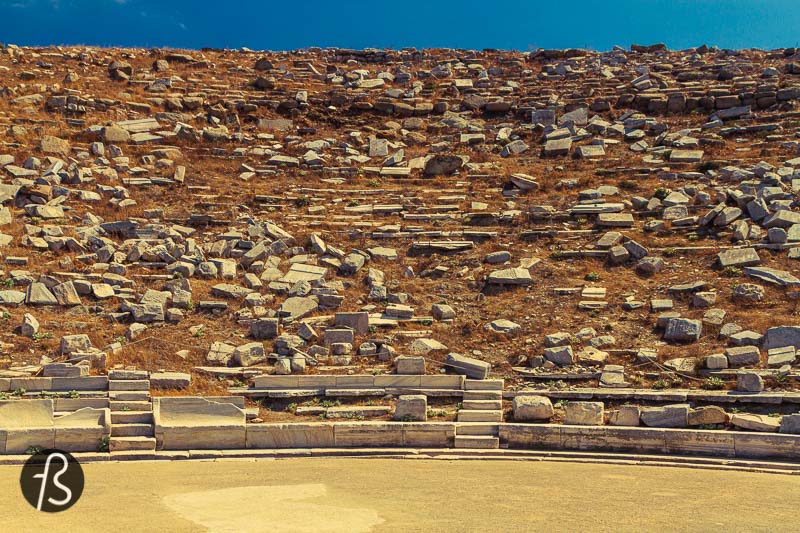

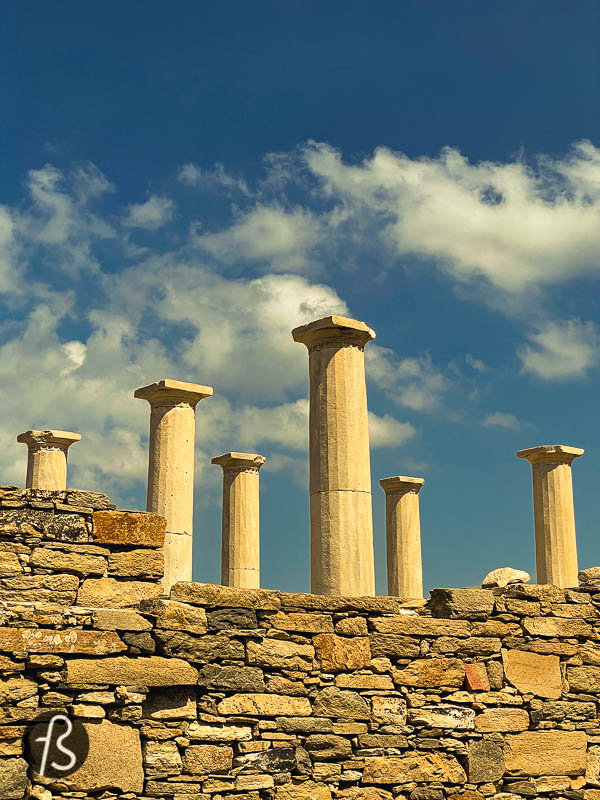
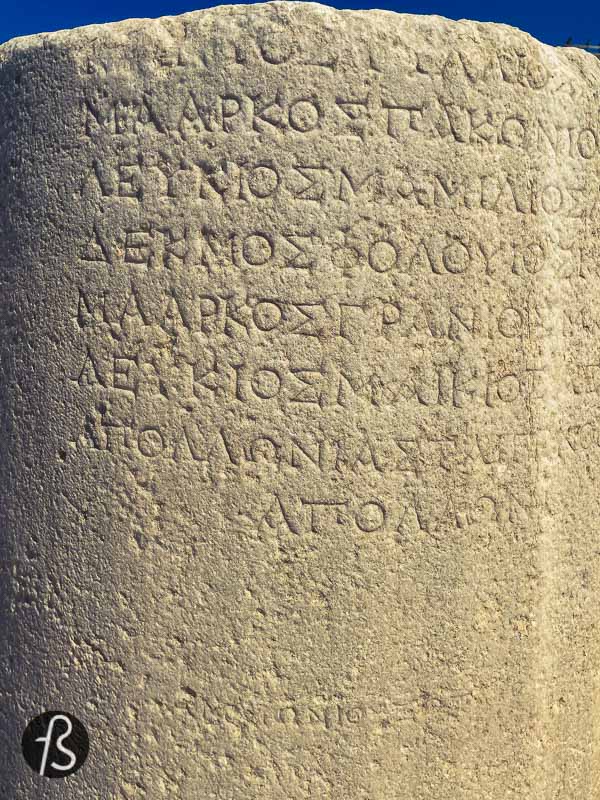

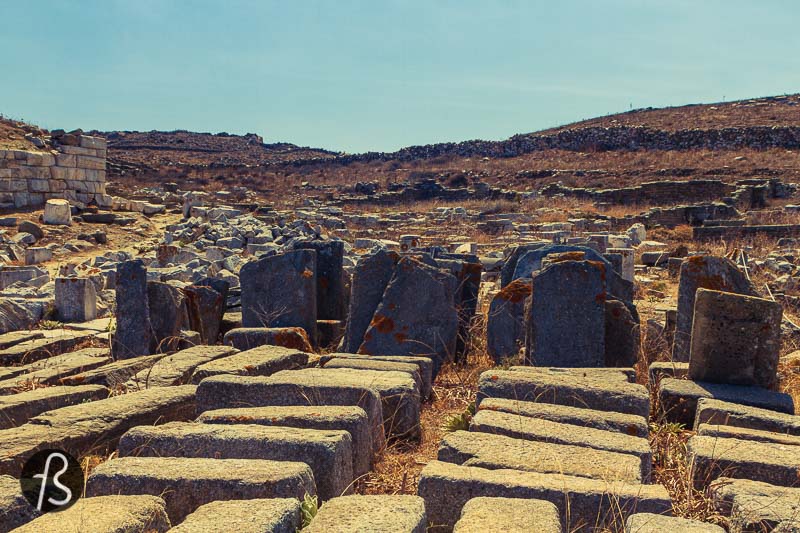
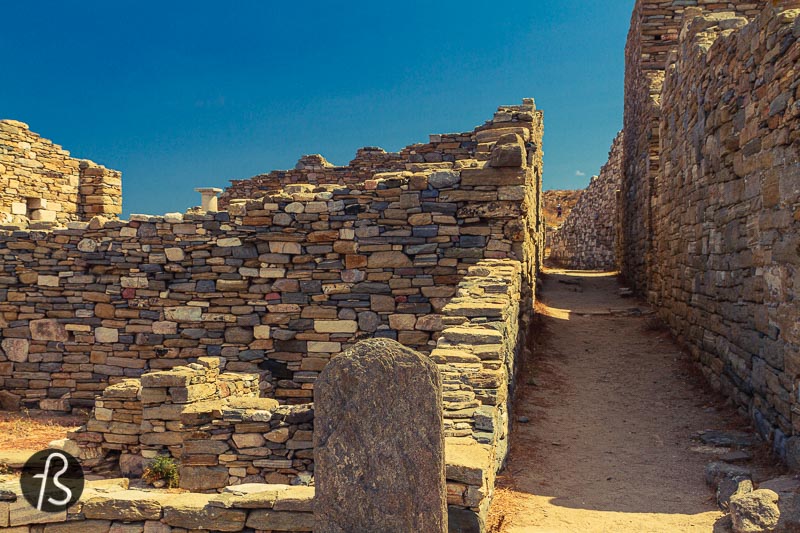
Delos Landmarks and Highlights
The small sacred lake where the twin gods, Apollo and Artemis, were born cannot be seen in its former shape and glory. It was intentionally left to dry due to problems with malaria and some disease-spreading bacteria. The place where the lake used to be is covered with plants, and palm tree marks the birthplace of the gods.
This was an underwhelming place to visit since there isn’t a lake there anymore. But, at the same time, it was fascinating since it’s the closest we have ever been to a genuinely mythological location. We have been to the Cave of the Apocalypse in Patmos during the same trip, so we can say that this was the most mythological trip we have ever taken in our lives.
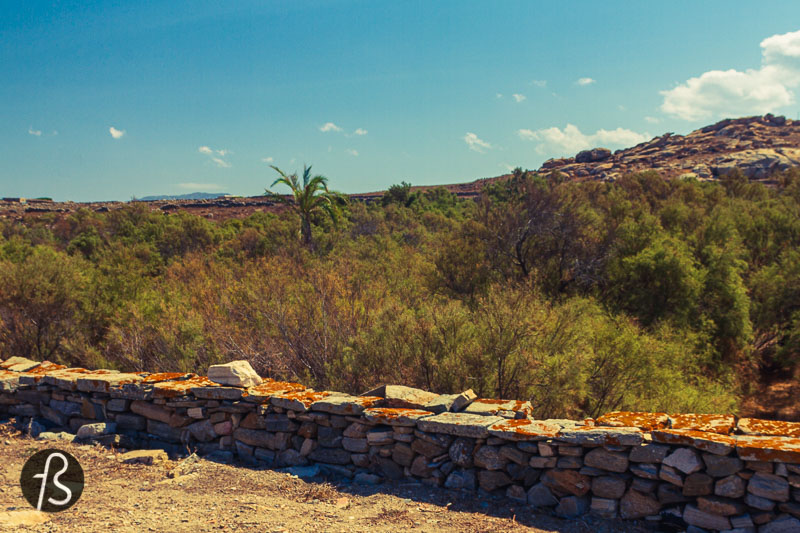
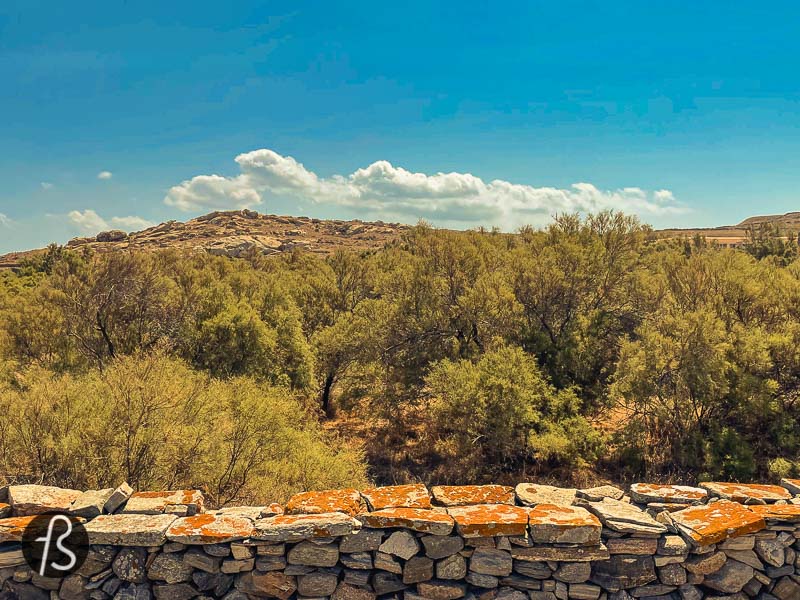

Across from the dry lake, you can find the Terrace of the Lions, where, initially, 12 stone lions were celebrating Apollo. Built around 600 BC, the lions face the Sacred Lake of Delos, and they were placed in a position to guard the lake, somehow.
With the lake on one side, the lions on the other and all the ruins that surrounded us, it was easy to start imagining how life used to be at peak of sacredness in Delos.
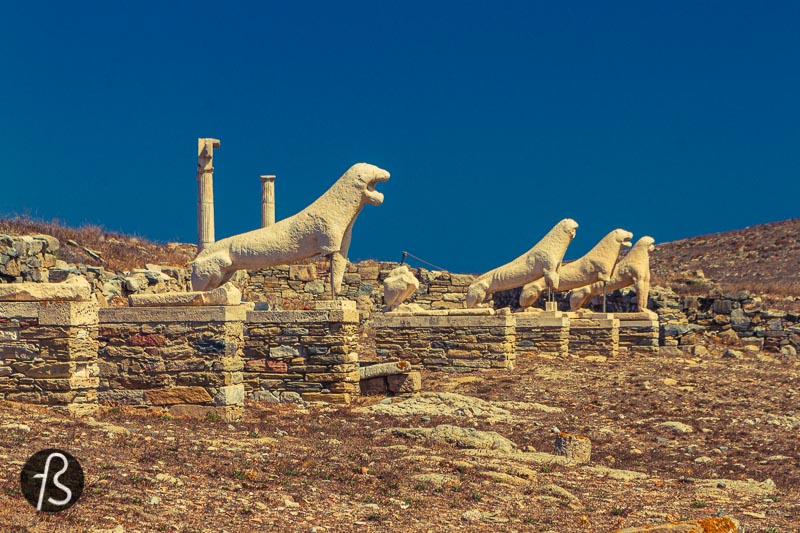

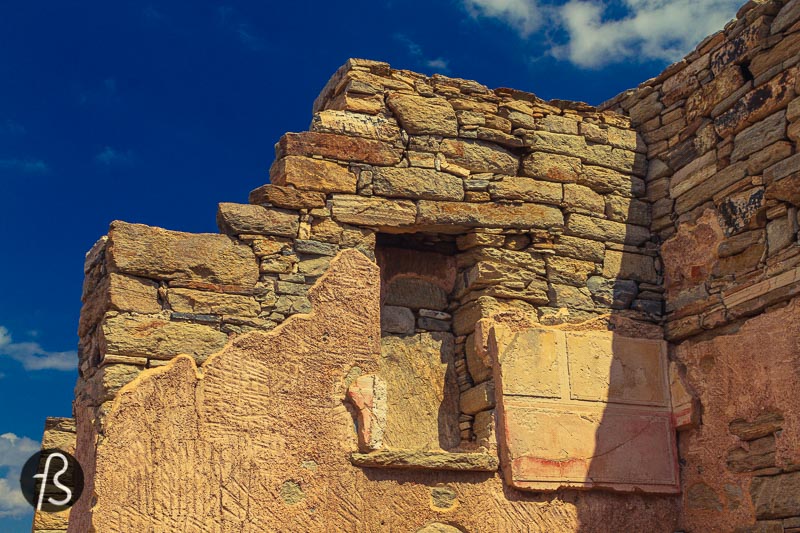
The House of Dionysos is a special place since it’s where you can find a mosaic of Dionysos riding a tiger. This mosaic is made of glass, faience, natural stones and terracotta, and it looks beautiful surrounded by marble pillars.
We often see mosaics like this in museums but this was a first time for us. And to be able to see it in its original place, surrounded by what remains of the house that holds it made this even more historically important to us.
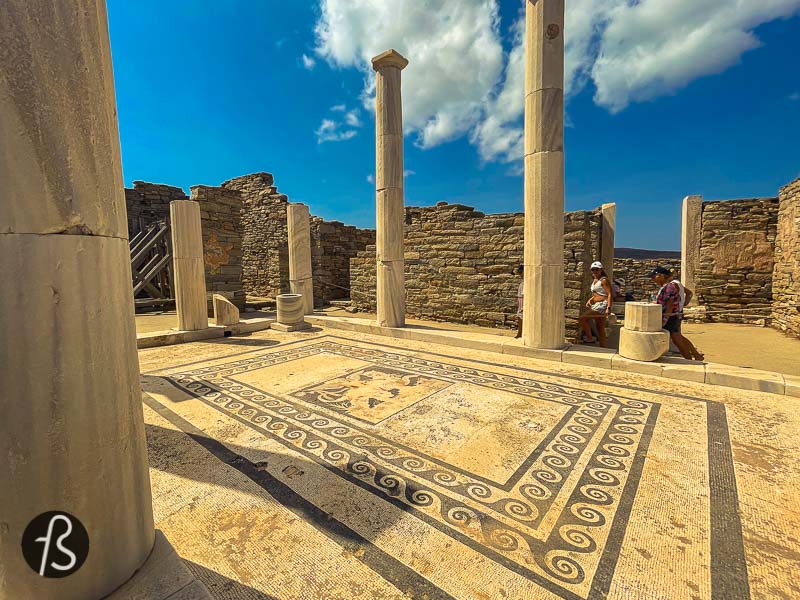
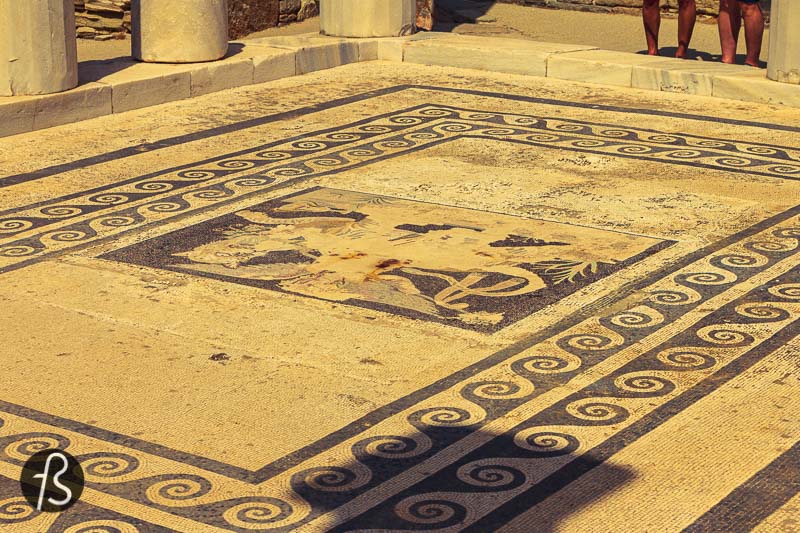
The House of Dionysos is a special place since it’s where you can find a mosaic of Dionysos riding a tiger. This mosaic is made of glass, faience, natural stones and terracotta, and it looks beautiful surrounded by marble pillars.
These were the most exciting places we saw during our time in Delos, but we found something special everywhere we pointed our camera there. The Agora of the Competaliasts is an easy place to wonder how these people lived on the island. The House of Cleopatra overlooks the harbour and presents us with two statues and some columns.
Another unique place is the Archaeological Museum of Delos, but we couldn’t visit it since it was closed when we were there, in August 2021. We managed to explore some of the artefacts there when we bought a book about Delos in the gift shop before we headed back to Running on Waves.
So, when in Delos, the best advice that we can give to you is to explore. Take your camera around, go for a walk, and we hope the weather allows you to take excellent pictures of this sacred place.


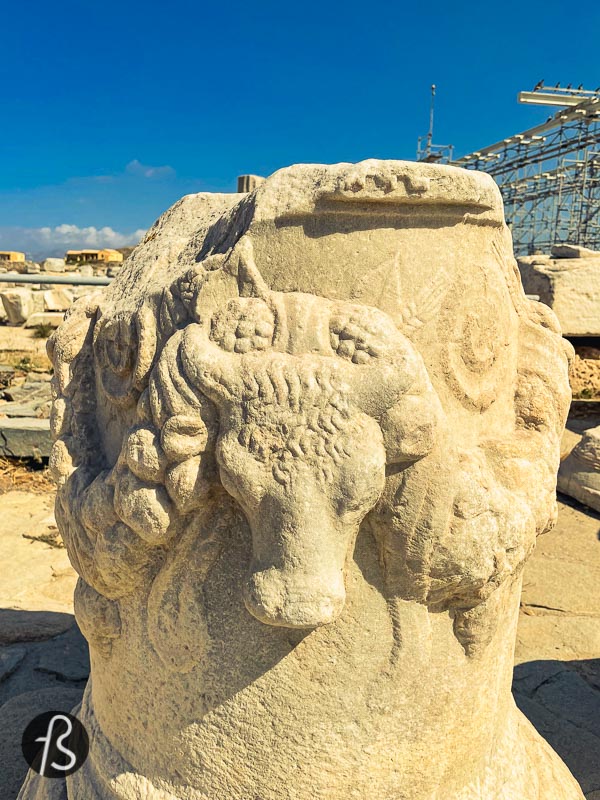

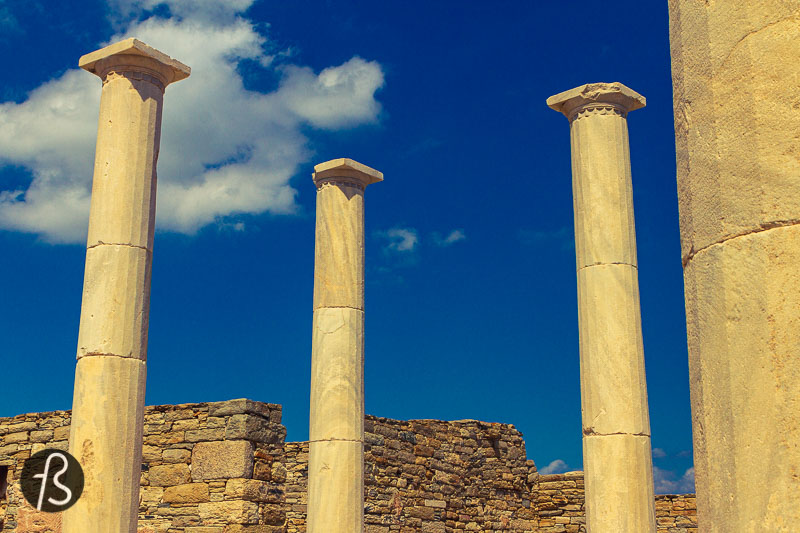

How to visit Delos?
You should take the ferries that go from Mykonos to Delos, and many make this trip, so you should research this once you are in Mykonos.
Remember that Delos is a visit-only archaeological site without accommodation; staying overnight on the island is impossible.
After all of this information on Delos, you might be asking yourself how many people live there. According to the Greek census from 2001, 14 people were living on the island, and we read on Wikipedia that, by 2011, there were 24 inhabitants.
But a new Greek census is being done in 2021, and we will know for sure once it’s released in 2024.
Delos: The Birthplace of the Twin Gods
Delos – Mykonos, Delos 846 00, Greece